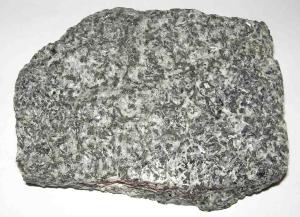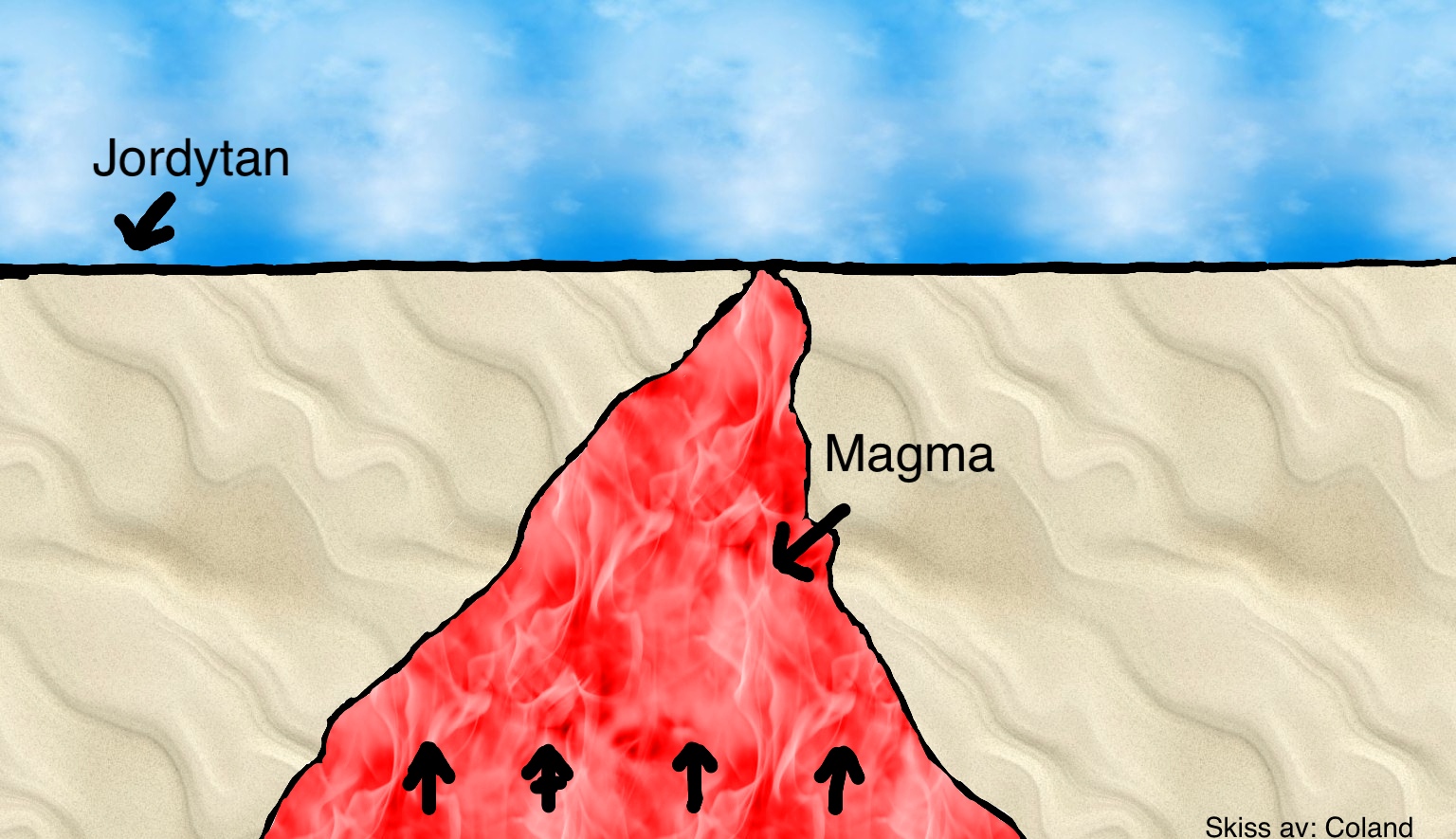[Swe]

Vegaplatsen
Vegaplatsen har fått sitt namn av Vegamonumentet som restes i samband med polaråret 1932–1933 till minne av Adolf Erik Nordenskiölds forskningsexpedition med fartyget Vega 1878–1880. Vegaexpeditionen var den första att hitta och färdas genom Nordostpassagen, sjövägen norr om Europa och Asien.
Namnen på Vegaexpeditionens medlemmar är ingraverade i monumentets sockel. Nordenskiöld blev professor för Naturhistoriska riksmuseets mineralogiska avdelning 1858. Han avled 1901, samma år som beslutet fattades att bygga Naturhistoriska riksmuseets anläggning i Frescati.
Obelisken är gjord utav diabas, möjligen från den så kallade svarta linjen, en diabasgång i Blekinge. Diabasgången består av hyperitdiabas och bildades för cirka 900 miljoner år sedan.

En gråfärgad bit diabas.
Diabas
Diabas är en mörk, fin eller medelkornig, magmatisk gångbergart. Till skillnad från basalt så har inte diabas bildats uppe på jordytan. Diabas har bildats som stelningsprodukter av magma, vilken från jordens mantel trängt upp genom sprickor eller gångar i jordskorpan. Huvudmineralen i diabas är plagioklas (labradorit) och pyroxen (augit), med mindre mängder av olivin, magnetit och illmenit. Den svarta färgen orsakas av pyroxen och ytterst små korn av järn- och titanoxid i den annars ljusa plagioklasen.

Magmatiska bergarter
Magmatiska bergarter, magmabergarter, bildas som stelningsprodukter av magmor (bergartssmältor) i eller ovanpå jordskorpan. I motsats till ett rent ämne (grundämne eller kemisk förening) saknar en magma specifik stelningstemperatur. När magman svalnar sker därför stelnandet, kristallisationen, inom ett stort temperaturintervall. Vid stelnandet utfäller magman normalt kristaller av flera olika mineral. Några typer av magmatiska bergarter är:
Vulkaniska bergarter
Vulkaniska bergarter och har bildats genom vulkanism på eller ytligt under jordytan. Magman avkylnar snabbt och blir därför glasiga eller finkornigt kristallina. Exempel på vulkaniska bergarter är tuff, ignimbrit och pimpsten.
Djupbergart
Magmatiska djupbergarter bildas av magma. När magma trycks upp så svalnar den eftersom att den trycks mot kallare stenar. Långsamt så stelnar magman. Så bildas till exempel granit och andra magmatiska djupbergarter.

En enkel skiss på hur gångbergarter bildas: magma trycks upp i sprickor i jordskorpan och stelnar sedan.
Gångbergart
Gångbergarter bildas genom att magma trycks upp i sprickor eller gångar i jordskorpan. När magman stelnar så bildas bergarterna. Ju snabbare avkylningen sker desto mindre blir mineralkornen och därmed ökar hårdheten i bergarten. Om sprickan eller gången är smal så kan en snabb avkylning ske. Då är diabasen oftast finkornigare och hårdare än diabas som har bildats i större sprickor eller gångar. Diabas är ett exempel på en magmatisk gångbergart.
Diabasbrytning i Sverige
Hälleforsgången i Södermanland är Sveriges största diabasgång. Åldern har daterats till cirka 1 550 miljoner år. Hälleforsgången är cirka 40 km lång och är som bredast 2 km.
Svarta linjen är en diabasgång i Blekinge. Gången består av hyperitdiabas som bildades för cirka 900 miljoner år sedan. Den höga densiteten, den korpsvarta färgen och svårigheten att få fram stora block gjorde diabasen dyrbar.
I Hägghult, i svarta bergens stenbrott, så finns det en berömd, helt svart, mycket finkornig diabas. Den svarta graniten bryts här än i dag och stenbrottet sägs vara världens största dagbrott för svart diabas. Längden är ungefär 900 meter, bredden 50 meter och djupet 75 meter.
Earthcachen
På de ovanstående koordinaterna så finner du en obelisk som är gjord utav diabas. För att få logga den här earthcachen som found så måste du svara på de nedanstående frågorna. Skicka dina svar till mig via e-mail. Skiv inga svar på frågorna i din logg. Loggar som inte följer detta kommer att raderas.
Uppdatering: På grund av det växande antalet personer som loggar mina earthcacher, och iochmed det ett växande antal personer som skickar svar till mig, så har jag beslutat att jag kommer från och med nu inte svara på alla mail som jag får med svar. Jag kommer fortfarande att läsa alla mail och om ni behöver skicka in nya svar så kommer jag att kontakta er. Så skicka era svar och logga sedan earthcachen och om ni skulle behöva ändra era svar så kommer jag att kontakta er.
1. Vad har diabasen på obelisken för färg? Tror du att den innehåller mycket eller lite pyroxen? Förklara ditt svar.
2. Titta lite närmare på diabasen: Är diabasen fin, medel eller grovkornig? Vad säger det om sprickan som diabasen har bildats i? Förklara ditt svar.
3. Titta lite närmare på diabasen: Vad finner man spår av i diabasen på obelisken? Du behöver inte ge det geologiska namnet, det räcker med vad det är för färg och vilken textur materialet har.
4. Frivilligt: En bild på dig och din GPS med obelisken. Detta är helt frivilligt och är inget krav för att få logga.
[Eng]
Vega Park
Vega Park takes its name from the Vega monument, which was erected in connection with the Polar Year 1932-1933. The monument is to commemorate Adolf Erik Nordenskiöld´s exploration expedition on board the vessel Vega in 1878-1880. The Vega expedition was the first to find and sail through the North-East Passage, the sea route north of Europe and Asia. The names of the expedition members are angraved in the base of the monument. Nordenskiöld became a professor in the mineralogical division of the Swedish Museum of Natural History in 1858, but he never had Frescati as his base. Nordenskiöld died in 1901, the same year as the construction of the new Swedish museum of Natural History was announced. It was planned to make Frescati a scientific center. The buildings of the Royal Swedish Academy of Sciences had recently been erected – they are visible on the other side of the motorway – and there were plans for an ethnographic museum here at the park. It was to stand along the south side of the park, as a counterpart to the south wing of the museum; to the east the area was bordered by Botanist House. However, the ethnographic museum was never built, and the scientific center did not come into being until the 1960s, when the university was moved to Frescati. The obelisk is made out of diabase, possibly from the so-called black line, a diabase once in Blekinge. The Diabase Passage consists of hyperitdiabase and was formed about 900 million years ago.
Diabase
Diabase is a dark, fine to medium grained, subvulcanic rock. Unlike basalt, diabase has been formed on top of the soil surface. Diabase has formed the solidification products of magma, which from the earth's mantle seeped up through cracks or veins in the crust. The main mineral in diabase is plagioclase (labradorite) and pyroxene (augite), with smaller amounts of olivine, magnetite and illmenit. The black color is caused by pyroxene and very small grains of iron and titanium oxide in the otherwise bright plagioclase.
Igneous rocks
Igneous rocks, magma rocks formed by solidification products of magmas (bergartssmältor) in or on the Earth's crust. In contrast to a pure substance (element or compound) lacks a specific solidifying magma temperature. When the magma is therefore cools solidification, crystallization, within a wide temperature range. Upon solidification of the magma normally precipitates crystals of various minerals. Some types of igneous rocks are:
Volcanic rocks
Volcanic rocks and has been formed by volcanism or shallow subsurface. The magma cools quickly and therefore glassy or fine crystalline. Examples of volcanic rocks are tuff, ignimbrite and pumice.
Intrusive igneous rocks
Intrusive igneous rocks are formed from magma. When magma is pushed up to cooler rocks it cools. The magma slowly cools. So are granite and other igneous plutonic rocks formed.
Subvolcanic rock
Subvolcanic rock is formed by magma pushed up into cracks or veins in the crust. When the magma solidifies so formed rocks. The faster the cooling, the lower the mineral particles and thus increases the hardness of the rock. If the crack or the time is so narrow, a rapid cooling occur. Then diabase usually finer and harder than diabase formed in larger cracks or passageways. Diabase is an example of a time igneous rock.
Diabase Quarrying in Sweden
Hälleforsgången in Södermanland is the largest diabase line in Sweden. The age has been dated to approximately 1.55 billion years. Hälleforsgången is about 40 km long and the widest point is 2 km. Black line is a diabase line in Blekinge. The line consists of hyperitdiabase which was formed about 900 million years ago. The high density, the raven black color and the difficulty in obtaining large blocks made this diabase precious.
In Hägghult, the black mountains quarry; there is a famous, completely black, very fine-grained diabase. The black granite mined here today and the quarry is said to be the world's largest open pit of black granite. The length is approximately 900 meters, width 50 meters and depth of 75 meters.
This Earthcache
At the above coordinates you'll find an obelisk that is made out of diabase. To log this earth cache as found, you must answer the following questions. Send your answers to me via e-mail. Write no answers to the questions in your log. Logs that do not follow this, will be deleted.
Questions:
1. What colour does the diabase have? Do you think that it consists of a large amount of pyroxene? Explain your answer.
2. Look a little closer at the diabase: is it fine or rough-grained? What does that say about the crack that the diabase was formed in? Explain your answer.
3. Look a little closer at the diabase: what do you find traces of in the diabase? You do not need to give the geological name, just describe the colour and texture.
4. Optional: upload a picture of you and/or your GPS with the diabase. This is not a logging requirement.
